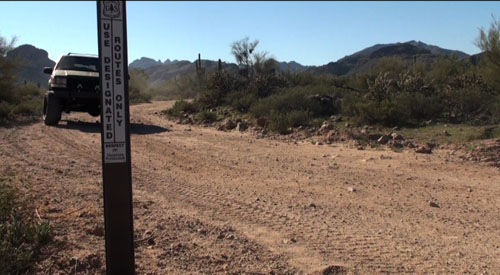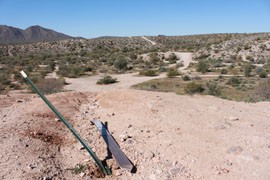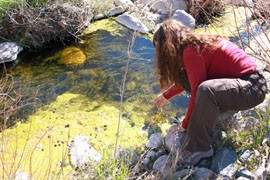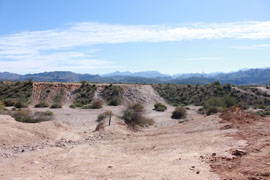Cronkite News has moved to a new home at cronkitenews.azpbs.org. Use this site to search archives from 2011 to May 2015. You can search the new site for current stories.
Off-road vehicle riders could see roads open in Tonto National Forest
MESA – Amy Racki picks up a broken “No motor vehicles” sign that she and the other Tonto National Forest park rangers installed in Bulldog Canyon just weeks ago to keep off-highway vehicle riders on authorized roads.
“People tear things out and are just very reckless sometimes,” she said.
Beyond the sign is landscape covered with well-traveled dirt paths criss-crossing the desert and leading toward challenging hills frequented by off-road riders.
But these trails are not on park maps, or authorized for travel.
“Some people are not informed that those hill climbs going vertical are not roads,” Racki said.
Illegal roads carved over time by ATVs, motorcycles and other vehicles are now the norm in areas like Bulldog Canyon, which borders Saguaro Lake. These trails become roads after only a few vehicles pass, as the fragile Sonoran Desert landscape is unable to regenerate.
Rather than continuing to discourage riders from leaving sanctioned roads, the U.S. Forest Service has proposed opening hundreds of miles of these “user-generated” paths to recreational users. It’s part of a larger Travel Management Plan that also would place restrictions on cross-country travel, or off-road riding.
In areas like Bulldog Canyon, the goal is allowing rangers to manage paths that already are seeing heavy use.
“Many of these roads are already safe and being used currently, it’s just that they’re not part of our database,” said Genevieve Johnson, the forest planner for the Tonto National Forest.
As a part of the planning process, the Forest Service is assessing whether the roads are safe for the public and the environment. The agency must abide by the National Environmental Policy Act by analyzing how trails may affect endangered species like the Mexican spotted owl.
While groups representing off-highway vehicle riders gave input on which routes to open under the plan, the Tucson-based Center for Biological Diversity is calling it irresponsible.
“They’re rewarding illegal behavior by designating a bunch of user-created routes, and it’s going to make the situation worse,” said Cyndi Tuell, a conservation advocate with the center. “Essentially the Forest Service is saying, ‘If you drive on it, we’ll designate it, we’ll put it on a map.’”
Tuell said each year wildlife corridors, archaeological sites and riparian areas are damaged by off-road vehicle use. The forest has a couple thousand too many roads open already, she said.
Johnson said the Forest Service is prohibited from allowing roads through endangered species’ habitats.
“We analyze effects on not only endangered species but general wildlife,” she said. “All of that goes into … a biological analysis for the Fish and Wildlife Service to review, and we’ll come to some agreement with them on whether that’s causing damage or not.”
Tuell also questioned if the Forest Service could afford to maintain any additional roads.
According to an economic analysis by the Tonto National Forest, it costs $6.9 million a year to maintain current roads. These roads are maintained through taxpayer dollars and with help from volunteers.
Johnson said the forest is in a unique position financially because many of the new roads that will be opened up are ready for use and won’t cost any money to build. If they aren’t ready, she said, they won’t be authorized until they are.
Though the Tonto National Forest doesn’t generate revenue from off-road vehicle use, travel management in general facilitates access to developed recreation sites that require visitors to buy passes, she said. The Tonto Pass Program currently brings in about $2 million annually, she added.
Johnson said the plan also addresses safety concerns because the Tonto National Forest doesn’t currently have any trails designated exclusively for ATVs and motorcycles. At present, those vehicles drive on the same routes as trucks and cars.
“There’s sometimes conflict between full-sized vehicles and motorcycles or ATVs,” Johnson said. “Having a designated, motorized trail system (for ATVs) … would provide a better recreation opportunity.”
Rich Smith, president of the Tonto Recreation Alliance, a nonprofit group for off-road enthusiasts, said the plan is important because the complex system of routes can cause people to get lost. The new travel management plan would provide licensed off-road vehicle users and law enforcement with a detailed motor-vehicle use map of where they can legally and safely recreate.
“The majority of off-road vehicle enthusiasts understand that this is a forest that is right next to a major metropolitan area – it does require some management, it does require some rules,” Smith said.
The travel management plan could also increase awareness among the off-road vehicle community, he added.
“Especially in the Southwest, people have the attitude that the land is free and open for everybody to use and they’re less conscious of it actually being a national forest,” Smith said. “We’ll be able to stop a lot of [illegal] activity.”
For Racki, managing and maintaining roads means that the Forest Service could potentially save lives.
“Saguaro Lake is where two of our fatalities were this year,” she said.











